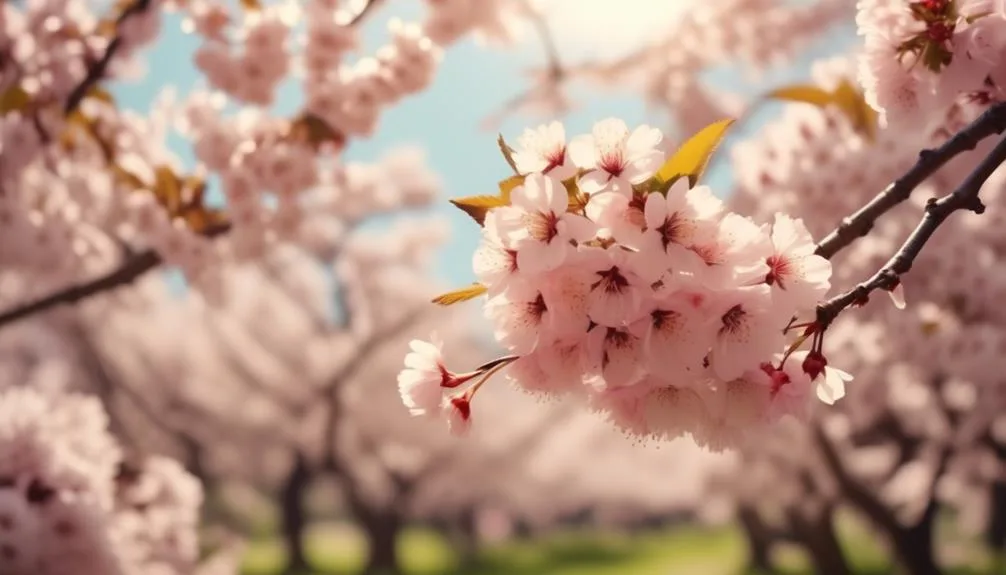Cherry trees have a significant impact on local biodiversity in urban areas. Their beautiful blossoms and foliage not only enhance the scenery but also attract pollinators and support native plant species.
This article explores how these majestic trees influence the web of life around them. From the ground up, we'll delve into the various ways cherry trees leave a lasting mark on the local ecosystem.
Cherry Trees and Pollinators
To ensure the successful pollination of cherry trees, it's essential for pollinators such as bees, butterflies, and other insects to visit the blossoms and transfer pollen between flowers. Cherry tree blossoms produce nectar, which is a vital food source for these pollinators.
The sweet scent and vibrant colors of the blossoms attract bees, who collect nectar and inadvertently transfer pollen from one flower to another as they forage. Butterflies also interact with cherry tree blossoms, sipping nectar and aiding in the pollination process.
The intricate relationship between cherry trees and these pollinators highlights the importance of preserving local biodiversity. By supporting the diverse species of pollinators, cherry trees contribute to the overall health and sustainability of the ecosystem.
Impact on Native Plant Species
How do cherry trees impact the native plant species in their surrounding environment?
Cherry trees, with their dense canopies and shallow root systems, can significantly affect the native plant species in their vicinity.
- Native Plant Competition
Cherry trees compete with native plants for resources such as water, sunlight, and nutrients, potentially leading to a decline in the growth and spread of native species.
- Ecological Balance
The introduction of cherry trees can disrupt the balance of the local ecosystem by altering the composition and distribution of native plant species. This imbalance may have cascading effects on other aspects of the ecosystem, including the wildlife that rely on these native plants for food and habitat.
The impact of cherry trees on native plant species underscores the complex interactions within ecosystems and the importance of maintaining ecological harmony.
Influence on Bird and Insect Populations
Cherry trees exert a profound influence on the populations of birds and insects in their immediate surroundings, shaping the dynamics of the local ecosystem. The abundance of nectar and pollen in cherry blossoms attracts a wide variety of insects, including bees, butterflies, and beetles. This, in turn, provides ample food sources for insectivorous birds, such as warblers and flycatchers. Additionally, the dense foliage of cherry trees offers shelter and nesting sites for various bird species. The timing of cherry blossom season also coincides with bird migration, providing crucial rest stops for migratory birds. On the other hand, cherry trees can also affect insect behavior, as certain species may rely on cherry tree leaves for feeding or reproduction. The interconnected relationship between cherry trees, birds, and insects highlights the significant impact of these trees on local biodiversity.
| Birds | Insects | Impact |
|---|---|---|
| Warblers | Bees | Food source |
| Flycatchers | Butterflies | Shelter and nesting |
| Migratory | Beetles | Rest stop |
Contribution to Soil Microorganisms
The presence of cherry trees in your local environment significantly enhances the diversity and activity of soil microorganisms, fostering a dynamic and thriving ecosystem. This contributes to improved soil fertility and overall ecosystem health. Here's why it matters:
- Nutrient Cycling: Soil microorganisms associated with cherry trees play a vital role in nutrient cycling, breaking down organic matter and making essential nutrients available to other plants. This enhances the overall soil fertility, supporting the growth of a wide variety of plant species in the area.
- Microbial Diversity: Cherry trees promote a rich diversity of soil microorganisms, including bacteria, fungi, and other microorganisms, which contribute to the overall health and resilience of the ecosystem. This diverse microbial community helps in maintaining soil structure, preventing erosion, and mitigating the impact of environmental stressors.
Role in Urban Biodiversity
Enhancing urban biodiversity, the presence of cherry trees contributes to the vibrant and interconnected web of life within your local environment. Urban green spaces, such as parks and gardens, play a crucial role in biodiversity conservation, and cherry trees are key components of this ecosystem. Their blossoms attract a diverse range of pollinators, including bees and butterflies, which in turn support the reproduction of other plant species. Additionally, cherry trees provide shelter and nesting sites for birds, further enriching the urban biodiversity. Below is a table illustrating the specific ways in which cherry trees enhance urban biodiversity:
| Cherry Trees in Urban Biodiversity |
|---|
| Attract pollinators |
| Provide shelter for birds |
| Contribute to urban green spaces |
The presence of cherry trees in urban areas not only adds natural beauty but also fosters a thriving ecosystem, promoting a healthier and more diverse environment.
Conclusion
Next time you walk among the cherry trees, take a moment to cherish their vital role in supporting local biodiversity.
From nourishing pollinators and birds to fostering native plants and soil health, these trees are essential for a thriving urban ecosystem.
Let's continue to safeguard and appreciate these magnificent trees to benefit all city-dwelling species.

My interest in trees started when I first saw the giant sequoias in Yosemite.
I was a teenager then, and I remember thinking, “I need to learn more about this.”
That moment stuck with me.
A few years later, I went on to study forestry at Michigan Tech.
Since graduating, I’ve worked in a mix of hands-on tree care and community education.
I’ve spent over ten years helping people understand how to plant, maintain, and protect the trees in their neighborhoods.
I don’t see trees as just part of the landscape.
They are living things that make a real difference in our daily lives.
